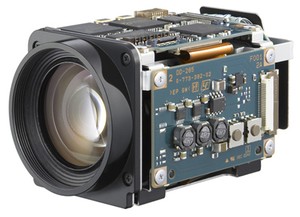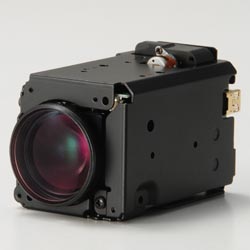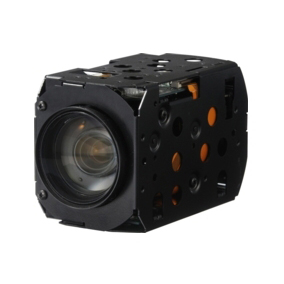Sony FCB-EH3100 Features:
The CMOS video camera provides 2,000,000 effective picture elements (pixels) that can shoot high-definition images to offer superior picture
quality.
* The camera is compatible with 8 formats, including the Full HD (1080i high definition) video format, which is equivalent to an HD-TV broadcast.
* HD: 1080i/59.94, 1080i/50, 720p/59.94, 729p/50
* SD: NTSC (CROP), NTSC (SQUEEZE)
* PAL (CROP), PAL (SQUEEZE)
* Video outputs
* HD: Analog Component, Digital (LVDS)
* SD: VBS, Y/C
* The camera is equipped with an ℅10 optical auto focus zoom lens.
* The ℅12 digital zoom function allows you to zoom up to ℅120, combined with a optical zoom.
* An infrared (IR) Cut-Filter can be disengaged from the image path for increased sensitivity in low light environments. The ICR will automatically engage depending on the ambient light, allowing the camera to be effective in day/night environment.
* The VISCA is a communication protocol, which enables the camera to be controlled from a computer.
* You can select the baud rate from among 9600 bps,19200 bps, or 38400 bps. This allows you to remotely control the camera at a high communication speed.
* The position preset function allows the camera to store up to six combinations of settings of camera shooting conditions. Also, the custom preset function allows you to customize the initial settings of each function when the power of the camera is turned on.
Sony FCB-EH3100 Specifications:
In general:
* Power On/Off
Powers the camera on and off. When the power is off, the camera is able to accept only the lowest level of VISCA Commands; the display and other features
are turned off.
* I/F clear
Clears the Command buffer of the FCB camera.
Clearing the buffer can also be carried out from the control application software when the power is on.
* Address set
VISCA is a protocol, which normally can support a daisy chain of up to seven attached devices. In this case, if addresses from 1 to 7 are assigned to each of
7 devices, you can control seven cameras with the same personal computer. However, the FCB camera does not support connection of cameras in a daisy
chain. Therefore, whenever a camera is connected for the first time, be sure to use the address set to confirm the address.
* ID Write
Sets the camera ID.
* Mute
Blanks the screen and sends out a synchronizing signal.
Zoom
* The camera employs an 10℅ optical zoom lens combined with a digital zoom function allowing you to zoom up to 120℅.
* Lens specifications: Optical 10℅, f = 5.1 mm to 51 mm (F1.8 to F2.1)
* The horizontal angle of view is approximately 50 degrees (wide end) to 5.4 degrees (tele end).
* Digital Zoom enlarges the center of the subject by expanding each image in both the vertical and horizontal directions. When 12℅ digital zoom is used,the number of effective picture elements in each direction reduces to 1/12 and the overall resolution deteriorates.
Focus
Focus has the following modes, all of which can be set
using VISCA Commands.
* Auto Focus Mode
The Auto Focus (AF) function automatically adjusts the focus position to the high frequency content of the picture in a center measurement area, taking into
consideration the high luminance and strong contrast components.
The minimum focus distance is 10 mm at the optical wide end (extreme close-up settings with VISCA control) (distance from the front end of the lens).
Normal AF Mode
This is the normal mode for AF operations.
- Interval AF Mode
The mode used for AF movements carried out at particular intervals. The time intervals for AF movements and for the timing of the stops can be set in one-second increments using the Set Time Command. The initial value for both is set to five
seconds.
- Zoom Trigger Mode
When the zoom is changed with the TELE or the WIDE buttons, the pre-set value (initially set at 5 seconds) becomes that for AF Mode. Then, it stops.
* Manual Focus Mode
MF (Manual Focus) has both a Standard Speed Mode and a Variable Speed Mode. Standard Speed Mode focuses at a fixed rate of speed. Variable Speed Mode has eight speed levels that can be set using a VISCA Command.
To stop the required operation after sending a Standard Speed command or a Variable Speed command, send the Stop command.
* One Push Trigger Mode
When a Trigger Command is received, the lens moves to adjust the focus for the subject. The focus lens then holds the same position until the next Trigger Command is input.
* Infinity Mode
The lens is forcibly moved to a position suitable for an unlimited distance.
* Near Limit Mode
Can be set in a range from about 4.5 m (2000) to 1 cm(C000).
The focus range is narrowed by excluding the unnecessary range.
White Balance
White Balance has the following modes, all of which can be set using VISCA Commands.
* Auto White Balance
This mode computes the white balance value output using color information from the entire screen. It outputs the proper value using the color temperature
radiating from a black subject based on a range of
values from 3000 to 7500K.
This mode is the default setting.
* Indoor
3200 K Base Mode
* Outdoor
5800 K Base Mode
* One Push WB
The One Push White Balance mode is a fixed white balance mode that may be automatically readjusted only at the request of the user (One Push Trigger),assuming that a white subject, in correct lighting conditions and occupying more than 1/2 of the image,is submitted to the camera.
One Push White Balance data is lost when the power is turned off. If the power is turned off, reset the One
Push White Balance.
* Manual WB
Manual control of R and B gain, 256 steps each
Automatic Exposure Mode
The variety of AE functions, which allow video signal to output the optimum image for subjects from low light conditions to bright light conditions, are available.
* Full Auto
Auto Iris and Gain, Fixed Shutter Speed (59.94/NTSC: 1/60 s, 50/PAL: 1/50 s)
* Slow shutter limit
Lower limit of the slow shutter mode in the Full Auto mode. For the 59.94/NTSC video format, select the lower limit from among 1/60, 1/30, 1/15, 1/8, 4/1 or
1/2.
For the 50/PAL video format, select the lower limit from among 1/50, 1/25, 1/12, 1/6, 1/3 or 1/2.
* Shutter Priority 1)
Variable Shutter Speed, Auto Iris and Gain(1/2 to 1/10,000 s, 21 steps, high speed shutter: 15 steps,slow shutter: 6 steps)
* Iris Priority
Variable Iris (F1.8 to Close, 18 steps), Auto Gain and Shutter speed.
* Manual
Variable Shutter, Iris and Gain.
* Bright
Variable Iris and Gain (Close to F1.8, 18 steps at 0 dB: F1.8, 6 steps from 0 to 18 dB)
* Spot light
Avoids a situation where the face of the subject is over-illuminated, and becomes whitish.
* AE 每 Shutter Priority
The shutter speed can be set freely by the user to a total of 21 steps 每 15 high speeds and 6 low speeds.
When the slow shutter is set, the speed can be 1/30,1/15, 1/8, 1/4, or 1/2 s. The picture output is read at a normal rate from the memory. The memory is updated
at a low rate from the CMOS. AF capability is low.
In high speed mode, the shutter speed can be set up to 1/10,000 s. The iris and gain are set automatically,according to the brightness of the subject
* AE 每 Iris Priority
The iris can be set freely by the user to 18 steps between F1.8 and Close.
The gain and shutter speed are set automatically according to the brightness of the subject.
* AE 每 Manual
The shutter speed (21 steps), iris (18 steps) and gain (8 steps) can be set freely by the user.
* AE 每 Bright
The bright control function adjusts both the gain and iris using an internal algorithm according to a brightness level freely set by the user. Exposure is
controlled by gain when dark and by iris when bright.
As both gain and iris are fixed, this mode is used when exposing at a fixed camera sensitivity. When switching from Full Auto or Shutter Priority Mode to Bright
Mode, the current status will be retained for a short period of time.
Only when the AE mode is set to ※Full Auto§ or ※Shutter Priority,§ the user can switch it to ※Bright.§
When switching from the Shutter Priority mode to the Bright mode, the shutter speed set in the Shutter Priority mode is maintained.
* Spot Exposure Mode
In Full Auto AE, the level for the entire screen is computed and the optimum Auto Iris and Gain levels are determined. In Spot AE, a particular section of the
subject can be designated, and then that portion of the image can be weighted and a value computed so that Iris and Gain can be optimized to obtain an image.
For example, in an image with a lot of movement and with varying levels of brightness, portions without much change can be designated as such a ※spot,§ and
changes to the screen can be minimized in that area.
As shown in the following diagram on the next page, a range of 16 blocks vertically and 16 blocks horizontally can be designated.
In the case where the center is designated (shown in black), the level is computed along with a weighted value for the surrounding block (shaded), including the
specified portions; and then the Gain and Iris are set.
The value of the designated portions and the surrounding areas should be calculated as 100%, the rest should be set to 20%. The range of the Spot AE frame is fixed to 5 blocks vertically and 4 blocks horizontally.
* Back Light Compensation
When the background of the subject is too bright, or when the subject is too dark due to shooting in the AE mode, back light compensation will make the subject
appear clearer.
* ICR (IR Cut-Removable) Mode
An infrared (IR) Cut-Filter can be disengaged from the image path for increased sensitivity in low light environments. The ICR will automatically engage depending on the ambient light, allowing the camera to be effective in day/night environments.
When the auto ICR mode is set to ON, the image becomes black and white.
* Auto ICR Mode
Auto ICR Mode automatically switches the settings needed for attaching or removing the IR Cut Filter.
With a set level of darkness, the IR Cut Filter is automatically disabled (ICR ON), and the infrared sensitivity is increased. With a set level of brightness,
the IR Cut Filter is automatically enabled (ICR OFF).
Also, on systems equipped with an IR light, the internal data of the camera is used to make the proper decisions to avoid malfunctions.
* Slow shutter 每 Auto/Manual
When set to ※Auto,§ ensures that the slow shutter is set automatically within the range of the lower limit set by the slow shutter limit command, when the brightness
drops. Effective only when the AE mode is set to ※Full Auto.§
Set to ※Slow Shutter Auto§ at shipment from the factory.
* Camera ID
The ID can be set up to 65,536 (0000 to FFFF). As this will be memorized in the nonvolatile memory inside the camera, data will be saved, regardless of the
※position preset.§
* Effect
It consists of the following functions.
Neg. Art: Negative/Positive Reversal
Black White: Monochrome Image
* Aperture Control
Aperture control is a function which adjusts the enhancement of the edges of objects in the picture.There are 16 levels of adjustment, starting from ※no enhancement.§ When shooting text, this control may help by making the text sharper.
* Exposure Compensation
Exposure compensation is a function which offsets the internal reference brightness level used in the AE mode by steps of 1.5 dB.
* Gamma
Selects the desired gamma curve of the camera.
Normal
Reproduces images with the standard video gamma curve.
Cinema Type 1
Reproduces images that look lively, providing depth in images as if you shot them using a film.
Cinema Type 2
In addition to the features of Cinema Type 1, this setting is capable of extremely precise description of the entire exposure zone, from shadowed parts to
highlighted parts, which enables reproduction of a deeper black.
* Freeze
This function captures an image in the field memory of the camera so that this image can be output continuously.
Because communication inside the camera is based on Vcycle, the captured image is always the one 3V to 4Vs after the sending of a Command. Thus, you can not specify a time period after sending EVEN, ODD or a Command.
* Others
Memory (Position Preset)
Using the position preset function, 6 sets of camera shooting conditions can be stored and recalled.
This function allows you to achieve the desired status instantly even without adjusting the following items each time:
Zoom Position
Focus Auto/Manual
Focus Position
AE Mode
Shutter control parameters
Bright Control
Iris control parameters
Gain control parameters
Exposure Compensation On/Off
Exposure Level
Backlight Compensation On/Off
Slow shutter Auto/Manual
White Balance Mode
R/B Gain
Aperture
ICR Shoot On/Off
* Custom Preset
As with the positon preset function, the camera shooting conditions can be stored and recalled. The settings are recalled when the power is turned on. | 






















